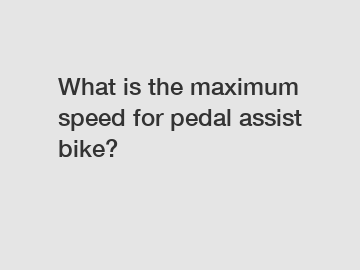What is the maximum speed for pedal assist bike?
Link to Seven Running
Pedal assist bikes, also known as electric bikes (e-bikes), have revolutionized the cycling experience by augmenting human pedaling power with electric propulsion. As their popularity continually surges, many riders are curious about the maximum speed achievable on these remarkable machines. In this article, we delve deep into the world of pedal assist bikes to explore their potential and determine the maximum speed attainable with their assistance, shedding light on the boundaries of this exciting mode of transportation.
Understanding Pedal Assist Bikes (120 words).

Pedal assist bikes are equipped with electric motors that provide proportional assistance to the rider's pedaling effort. This user-friendly mechanism allows individuals to tackle long distances, steep ascents, and challenging terrains more easily than on conventional bicycles. However, it is essential to recognize that pedal assist bikes do not function as throttle-controlled motorcycles, but rather offer varying degrees of assistance depending on the cyclist's input. This distinction ensures they comply with legal regulations and are classified as bicycles across most jurisdictions.
Determining the Factors (180 words).
To determine the maximum speed achievable with pedal assist bikes, several factors must be considered. The primary factors include:
1. Motor Power: The wattage of the electric motor significantly impacts the maximum speed attainable. Higher wattage numbers generally result in increased speed potential.
2. Rider's Input: Pedal assist bikes rely on the rider's pedaling effort to activate the electric assistance. Consequently, maximum speeds can vary depending on the cyclist's strength and stamina.
3. Bike Design: The aerodynamic build and weight distribution of the bike itself influence its capacity to reach higher speeds. Lightweight frames and sleek designs can improve performance.
4. Terrain and Weather Conditions: Uphill gradients, strong headwinds, or adverse weather conditions can hinder speed potential. Flat terrain and favorable weather conditions, on the other hand, can contribute to achieving maximum speeds.
Maximum Speed Restrictions (180 words).
While pedal assist bikes can reach thrilling speeds, it is crucial to respect the legal regulations in force. In many countries, the maximum assisted speed for e-bikes is typically capped at 15.5 to 20 miles per hour (25 to 32 kilometers per hour). This limitation recognizes the necessity for a harmonious integration of e-bikes with traditional bicycles and safeguarding the safety of both riders and pedestrians.
Challenging the Limits (180 words).
However, it is worth noting that beyond these legal restrictions, specially designed pedal assist bikes have been developed with the ability to reach higher speeds. These advanced models, known as speed pedelecs or high-speed e-bikes, often feature more powerful motors and shifting mechanisms that enable speeds of up to 28 to 32 miles per hour (45 to 50 kilometers per hour). It is essential to note that these speed pedelecs may require additional registration, licensing, and compliance with specific regulations due to their enhanced capabilities.
Conclusion (60 words).
Pedal assist bikes have garnered immense popularity due to their ability to help riders tackle various terrains with ease. While the maximum speed for standard pedal assist bikes is limited by regulations at around 15.5 to 20 miles per hour, specialized high-speed e-bikes can push the boundaries to reach speeds of up to 28 to 32 miles per hour. However, regardless of the maximum speed potential, safety and adherence to local regulations should always be a priority when enjoying the pedal-assisted cycling experience.
Please visit our website for more information on this topic.
If you are looking for more details, kindly visit Children Pedal Bikes.